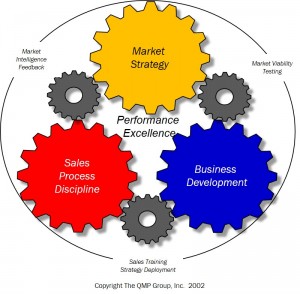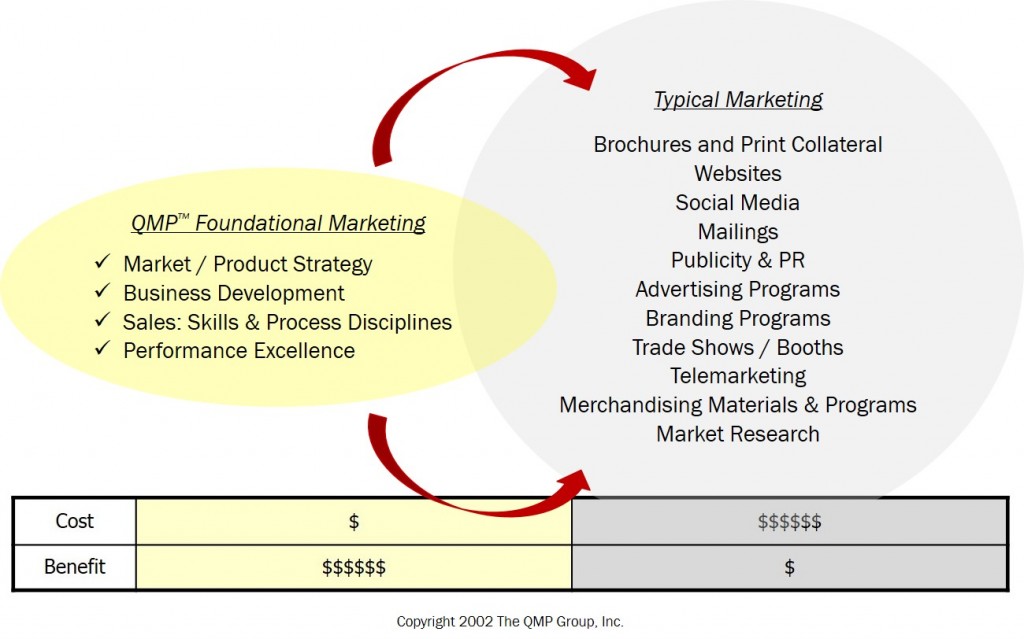A Good Brand: Cause or Effect?
Perhaps it’s a result of living in the Northwest for the last 20 years that I am periodically afflicted by the “salmon complex” – the uncontrollable impulse to swim against the current, despite obstacles. And so it is, I find myself in such a stream with regard to the growing pandemonium toward B2B branding programs. It’s not that I don’t believe that “Brand” has value, in fact, just the opposite. Brand has enormous value. It’s just that brand power is the effect, not the cause of B2B market success – and the strategic research proves it.
I have had the opportunity to observe a wide range of branding initiatives at B2B companies. At opposite ends of the spectrum, two come to mind. The first was a simple logo redesign for a small private company. The other, a million-dollar comprehensive branding initiative for a mid-market public firm. Neither initiative seemed to have any visible impact on the firm’s earnings.
After those initiatives had been in place a while, I asked the executives of each company whether they thought their branding program was a success. The answer, in each case, was an unequivocal “No”.
Not too long ago I gave a talk on market strategy to MBA students at a prestigious local university. At the end of the talk, one of the students approached me and expressed amazement and disbelief. How could I possibly give a detailed talk on market strategy without mentioning the importance of branding? He was agitated and animated, his arms waving about as he skittered around in front of me, like a drop of water on a hot skillet. It was as if I had missed stating the importance of water to agriculture.
So, why all the hysteria and stampede around branding?
Even though branding programs often fail to move the needle – their popularity remains ubiquitous. There are a number of reasons for this:
- It feels good: A new brand. A refreshed tag line. A fantastic logo. A clean, well-constructed website. Looking at these products of a branding program makes you feel good. Customers can quickly see the highly visible outcomes. Executives smile at the wondrous accomplishment, reinforced by the adulation of their peers telling them how snappy it all looks.
- The majority of the creative energy needed can be subcontracted to, and accomplished by, outside folks – minimally increasing anyone’s internal workload
- Marketing and sales teams are hounding their management to spend money on branding
- Branding gives the marketing team something concrete to focus their energy on – something on which to build a whole marketing communications program
- Websites need to be constantly refreshed anyway – and a rebranding typically does that in a big way
- There’s little downside risk, except for the money spent
- Everybody’s doing it, and
- Everybody’s selling it
Now, please don’t get me wrong. I sincerely appreciate the value of a good brand image in attracting customers – but a brand (the image, interpretation and meaning of your name, tag line and logo) is an effect not a cause, of success. What impact would the Apple logo have if Steve Jobs hadn’t first amazed the world with a steady stream of mind-blowing, innovative products?
What your company and its products and services mean to their target markets, i.e. the customer experience surrounding your value proposition, must have already been delivered and validated in the marketplace before a brand can be meaningfully established.
Strategic Marketing Research and RPQL
The voluminous PIMS* database and research from the Strategic Planning Institute, conclude that the customer’s perception of a product’s quality relative to its competitors, is the prime driver of financial success. This is called RPQL – Relative Perceived Quality Leadership. The research concludes that financial success is the outcome of achieving RPQL – and brand power is also a result of RPQL – not the other way around.
Quality means more than just “it won’t break”. It means that the product or service experience meets customer expectations – consistently delivering on its promises. And, delivering a relative perceived quality leadership experience takes consistent organizational rigor and discipline. No matter the logo! The customer must experience RPQL first hand, and then the synaptic connection can be made to the brand name and logo.
Achieving the Branding Impact You Intend: 5 Steps
- Develop, deliver and confirm a meaningful value proposition experience first:
The Law of Value Exchange states, “The source of all economic value in your company originates from a customer’s willingness to exchange their cash for what, in their perception, delivers greater economic, physical, emotional or political value in return.”
- Assure that your value proposition targets a market with substantial momentum and potential:
The world’s best boat, sporting the flashiest logo and most clever tag line goes nowhere in a river that is devoid of water. And remember, a brand has different meanings to different markets. Focus your investment and energy developing a meaningful RPQL experience in a meaningful growth market.
- Don’t muddle corporate and product branding:
Smaller companies with petite marketing budgets often try to create one brand for the whole firm. But they may be serving multiple market segments with different products delivering different value propositions. In such a situation, it might better to focus branding budgets on specific products, vis-à-vis branding the whole firm. For example, the GM (General Motors) brand has been badly damaged recently by a torrent of recalls, however one brand RPQL experience (Corvette) remains solid.
- Understand what your firm means to your best customers:
I asked new and returning clients why they buy from QMP. I was surprised; it really wasn’t what I thought. When I repeatedly heard the same reply, I immediately changed the corporate logo to reflect that perceived value and experience. Here is the QMP logo.
Yup. Our clients told us they engage with QMP because they gain invaluable insight because we challenge them to think.
- Align your brand:
Alignment does not mean just marketing materials, fonts and messaging. It means your whole damned company. From employee recruiting, to training, to product design, values, culture and customer service. All components must be aligned to reinforce the customer RPQL experience – which is your brand. When you invest in that kind of brand discipline, your brand promise will be delivered.
*****
*PIMS stands for the Profit Impact of Market Strategy, a data base initiated by GE in the 1960’s to study the connection between strategy and profit. It is now maintained by the Strategic Planning Institute. It has tracked more than 500 key metrics of thousands of companies since the 60’s.
For more information on branding success contact Jerry Vieira at The QMP Group 503.318.2696 or Jerry@qmpassociates.com













